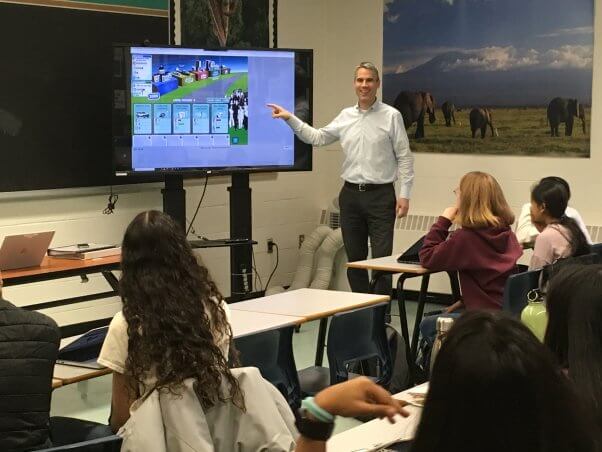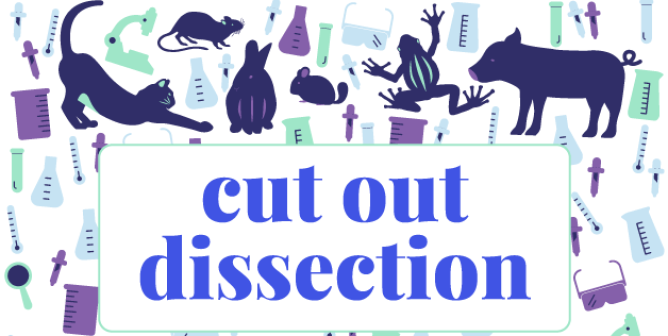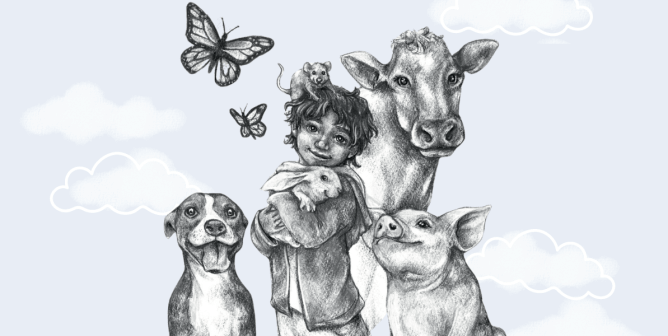Teacher Spotlight: Meet Mike Farley
The Teacher Spotlight highlights the work of various humane educators, giving them a chance to share their stories and tips and inspire other compassionate teachers like you to take action for animals through education.

Meet Mike Farley, a middle school teacher who’s been instilling empathy for animals in his classroom for over 12 years. He leads a compassionate lifestyle, having gone vegan over two years ago after being vegetarian for 20 years. His decision to go vegan was prompted by his family’s addition of a rescued dog with an unfortunate past.
He notes that after he and his wife adopted their dog, “Something switched on deep inside of us, and we haven’t looked back since.”
How does compassion for animals fit into a geography and environmental studies curriculum?
In my province of Ontario, compassion for animals is not really explicitly stated in the standardized middle and high school curriculum. Having said that, the geography curriculum expectations are quite broad and issues-based, and so I find that there’s some leeway to incorporate compassion for animals. For example, this year, I’m using the following grade 9 expectation to investigate factory farming and, subsequently, plant-based and cell-based meat alternatives: “Analyze the effects of food production practices, distribution methods, and consumer choices on the sustainability of Canada’s food system.” For my grade 7 geography course, I have tentatively planned a field trip to a local donkey sanctuary, to be followed up by having students design their own sanctuaries in different biomes around the world.
How has studying animal issues benefitted your students?
I see some immediate benefits, while I think others are more subtle and long-term. In the short term, for example, after learning about the practice of shark finning, many of my students have sworn off things like shark fin soup. Long-term benefits are harder to track, but I like to think that in some way, seeds are being planted that may emerge later on. I know this was my own experience in high school, and I am indebted to many of my teachers who introduced me to important topics that set something in motion within me, even though I didn’t know it at the time!
What has been the response of your school community (administrators, other teachers, parents, etc.) to your use of humane education?
I am very fortunate to be teaching at a school with a progressive staff who are open to a wide array of important issues. Some staff are even incorporating animal rights issues into their own teaching contexts. Fortunately, I have never had a parent challenge me on incorporating animal protection into my courses.
What challenges, if any, do you face as a humane educator, and how do you overcome them? How do you educate students about animal issues without “preaching”?
I think one of the main challenges is avoiding a top-down approach and not merely preaching to the students. I like to introduce topics but give my students a lot of space to explore them and come to their own conclusions. On the other hand, another challenge is to avoid letting the pendulum swing too far the other way and not introducing animal rights issues at all. I have to listen to my heart and connect with how dire the situation is for so many animals. It’s tough to find the right balance, and it’s something that I struggle with on a continual basis—it’s an ongoing and evolving process.
Tell us about ChangeGamer and your experiences in game-based learning.
I stumbled upon game-based learning about 15 years ago and quickly realized that video games were powerful and engaging teaching tools for exploring serious issues. Students, even those who were generally disinterested, were staying up late into the night playing the games and coming to me the next day with a robust and nuanced understanding of incredibly complex issues such as war, climate change, natural disasters, economic disparity, and human migration. Since then, I’ve used about 40 digital games for students ages 12 to 18. I founded ChangeGamer formally about five years ago to bring together other teachers who are passionate about game-based learning and open to sharing their expertise. We test existing games with our classes and then create accompanying curriculum to enhance student learning. All the curriculum is available for free at ChangeGamer.ca.

Do you experience “compassion fatigue”? If so, how do you remedy it?
I’m not sure if it’s compassion fatigue or simply feeling overwhelmed by the enormity of issues such as animal rights. The numbers and the degree of depravity are staggering, and at times, I wonder what impact I’m actually having. I look for small (and sometimes big) victories, and I draw inspiration from the countless amazing people advocating for animals. I also frequently visit reputable animal sanctuaries, which I think are some of the most sacred places on our planet.
You recently brought together a number of humane educators in your community to network. Why was this important to you?
My wife and I were inspired by the Canadian group Animal Justice, which is a collection of legal professionals using their unique skill sets to advocate for animals. We were having difficulty finding a comparable group of educational professionals in our city, and so we had a big party and invited as many people as we could think of. Some really cool things happened. First, many of the educators were grateful to come together, because they were alone in their efforts in their own schools. Second, we had a wonderful turnout from staff from our own school, which created some special bonds. Finally, we had some delicious vegan Indian food!
What advice would you give to someone who wants to start engaging in humane education but isn’t sure where to begin?
I would recommend connecting with other educators, either in person or online. Organizations like TeachKind and the Institute for Humane Education are great places to start. I also think you can start with small steps and test the waters—try sprinkling in some activities that incorporate compassion for animals and see what the response is. Sharing personal experiences has also helped me connect with the students at a deeper level.
*****
Inspired to start teaching compassion for animals in your classroom? TeachKind will walk you through every step of the process and provide free resources along the way.





